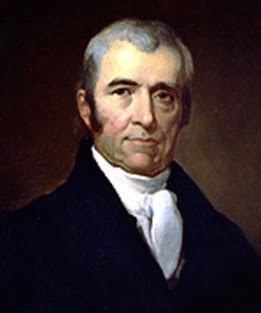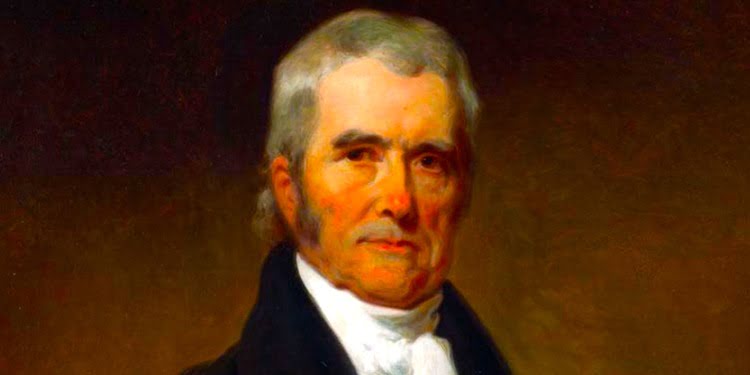 John Marshall was born on September 24, 1755 at Germantown (now Midland) in what became Fauquier County, Virginia four years later. He served first as lieutenant, and after July, 1778, as captain in the Continental Army in the Revolutionary War.
John Marshall was born on September 24, 1755 at Germantown (now Midland) in what became Fauquier County, Virginia four years later. He served first as lieutenant, and after July, 1778, as captain in the Continental Army in the Revolutionary War.
John Marshall spent the winter of 1777-1778 with the troops in Valley Forge.In 1781, he resigned his military commission and studied law. He soon began practicing in Fauquier County and later in Richmond. In 1786, he won a case of great importance regarding land known as the northern neck of Virginia. From this time, he maintained leadership of the bar of Virginia. He was a member of the Virginia assembly in 1782-91 and 1795-1797. He took a leading part in the Virginia convention called to act in 1788 on the proposed Constitution of the United States. In 1795 he was offered the attorney-generalship by Washington and the position of the Minister to France in 1796. He declined both offers. He did spend the autumn and winter of 1797-98 in France as one of the three commissioners appointed by John Adams to adjust the differences between the young republic and the directory. The commission failed, but the course pursued by Marshall was approved in America. Because of the resentment felt by the public at large of the way the commission was treated in France, he returned to United States exceedingly popular. This popularity and the advocacy of Patrick Henry aided his election as a Federalist to the House of Representatives in the spring of 1799 even though the sentiments in Richmond were overwhelmingly in favor of the opposition of the Republican Party. He was Secretary of State under Adams from June 6, 1800 to March 4, 1801. In the meantime he had been appointed Chief Justice of the Supreme Court, his commission bearing the date January 31. Thus while still Secretary he presided as Chief Justice.
After the death of George Washington, as an expression of his love and loyalty, Chief Justice Marshall hastily composed a biography of his revered chief (1804-07). It contained five volumes. In 1832 he shortened the work to two volumes with an introductory book of Colonial history.
On a personal note, John Marshall married Mary Willis Ambler in 1782. She was the daughter of the then treasurer of Virginia. They had ten children, six of whom grew to full age.
His wife died in 1831 and he was never quite the same again. On returning from Washington in 1835, he was in a stagecoach accident, suffering severe injuries. His health, which had not been good, rapidly declined and in June he returned to Philadelphia for medical assistance. There he died on July 6. His body was taken to Richmond and he was buried in Shockhoe Hill cemetery.
As a tribute to his judicial service a bronze statue stands on the lower west terrace of the Capitol. It represents the Chief Justice, sitting in his judicial robe, expounding some subject of great interest to him. The statue looks toward the monument of Washington whom he so greatly admired.
